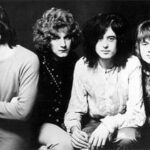Eric Clapton stepped into the spotlight for the first time with the Yardbirds. Clapton abandoned the potential for a commercially successful career with the Yardbirds because he felt they had strayed from their blues roots. The Yarbirds were set to follow the commercial path of their musical colleagues the Beatles and the Rolling Stones. Clapton was much more interested in following the path of his blues heroes such as Robert Johnson. He joined John Mayall and the Bluesbreakers and and embarked on a career as a serious blues musician.
Background Of The Bluesbreakers
Eric Clapton joined John Mayall’s Bluebreakers in 1965. Their collaboration marked a turning point in both of their careers. Clapton had already developed a loyal following in England because of his tenure with the Yardbirds but he left the band because of his disenchantment with the “pop” direction he felt they were taking. Mayall was one of the leader figures of the British blues movement but he was struggling commercially at the time. Decca Records terminated Mayall’s contract after an unsuccessful live album.
Mayall formed the Bluesbreakers in 1964 wit Hughie Flint (drums), John McVie (bass) and Roger Dean (guitar). Despite the enthusiasm for blues among the young British crowd, the Bluesbreakers couldn’t achieve the success of the contemporaries such the Rolling Stones, Eric Burdon and the Animals, and the Yardbirds. The music writer Neil Slaven suggested that Mayall consider Clapton for the band. Mayall followed Slaven’s advice and asked Clapton to join the Bluesbreakers in April of 1965. In the liner notes for the album Slaven wrote: “The person responsible for much of the improvisation is Eric Clapton, Two years ago I stuck my neck out to say that Eric would become one of the top blues guitarists in the country. Now I know I was right – he is the best damn it.”
Clapton flourished under Mayall’s mentoring. Mayall exposed Clapton to electric guitarists such as Otis Rush and Freddie King. Mayall and Clapton spent numerous hours listening to and studying blues records in Mayall’s aparment. The addition of Clapton on guitar allowed Mayall and Bluesbreakers to flourish as well. Clapton departed to form Cream within the year but he was the first of several important British blues guitarists develop under Mayall’s guidance. Clapton was replaced by Peter Green who went on to found Fleetwood Mac, Mick Taylor took Green’s slot. Taylor later joined the Rolling Stones in 1969.
Review of the Beano Album
The official title of the album is Bluesbreakers John Mayall with Eric Clapton, however the album is usually referred to as the Beano album because Clapton is reading on Beano comic book in the photograph on the front of the album.
There are twelve songs and two bonus tracks, fourteen songs altogether. The first two songs on the album announced a new era in rock guitar and laid the foundation for Clapton’s reputation as the new guitar The first song is a version of Otis Rush’s All My Loving. Clapton’s guitar is front and center as he kicks off the opening riff. The heavy distortion and sustain of Clapton’s Les Paul announced a new era of rock guitar. Freddie King’s instrumental Hideaway up and Clapton attacks it very aggressively.
The two songs which showcase Clapton’s own unique style, that he later developed with Cream, are the slow blues Have You Heard and the instrumental Steppin’ Out. Have You Heard is the longest song on the record (5.52 minutes) and it allows Clapton to stretch out Steppin’ Out is the tune where Clapton’s confidence seems most on display. While he the other numbers aren’t lacking in confidence, this tune sees some of the licks that became the building blocks for many of Clapton’s solos. He continued performed Steppin’ Out with Cream.
One of the other gems on the album for Clapton fans is Ramblin’ On My Mind. The song is particularly interesting for two reasons. It is the first time Clapton recorded a Robert Johnson song and it is the first time that Clapton sang the lead vocal on a song. The song is also played as a duo with Mayall on piano and Clapton on guitar. The guitar is turned down and more mellow that on the other tunes.
Although numerous musicians have passed through the Bluesbreakers, this original band was certainly one of the best. It secured Mayall’s reputation not only as a blues musician in his own right but also his role as a blue mentor. Clapton’s credits maturity as influence. Mayall, himself, is in fine form on the album handeling organ, piano, and harmonica duties in addition to the vocals. He pays his respects to Sonny Boy Williamson on Another Man and to Little Walter on It Ain’t Right. Flint and McVie provide a strong rhythmic groove that gives Clapton that freedom soar on the guitar. The album marks the beginning of Clapton’s career as a serious blues guitarist. He demonstrates a thorough knowledge of his heroes such as B B. King,



